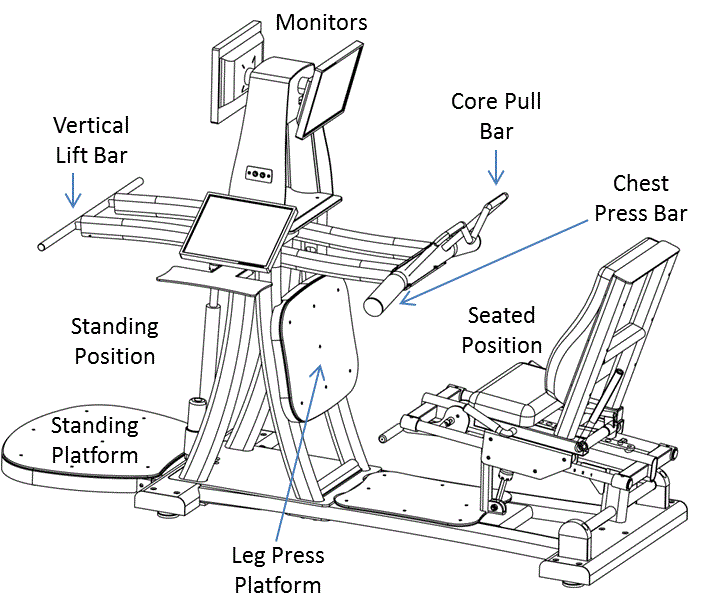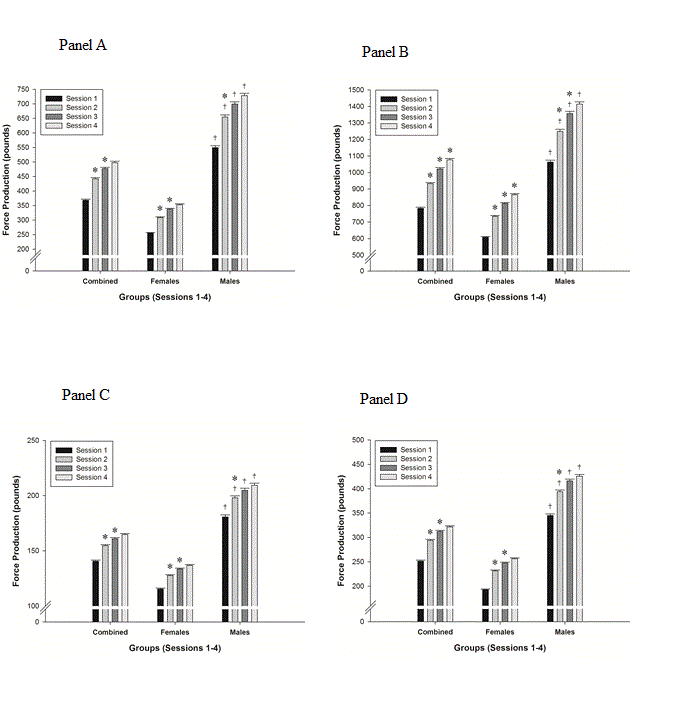Experimental approach: The methods are divided into two sections: 1) description, explanation, and contextual reference for the bioDensity™ equipment and approach; and 2) research design for the cross-sectional analysis of bioDensity™ force production data to account for learning effect that may influence quantifying a stable baseline in males and females.
What is bioDensity™?
BioDensity™ (Performance Health Systems, Inc., Northbrook, IL) is both the name of the novel RT equipment/modality and a commercially developed approach to neuromuscular and osteogenic loading [
21]. At the foundation of its design and development in 2005 was the need for a “safe, self-induced, osteogenic loading stimulation” inducing a neuromusculoskeletal stimulus that provides levels of loading up to multiples of body weight [
21]. It appears evident from the manufacturer and equipment development that the guiding health-related applications of bioDensity™ were to promote bone and neuromuscular health [
21,
26]. The bioDensity™ equipment is depicted in Figure 1, and a more detailed explanation of the equipment, theoretical underpinnings and approach can be found elsewhere [
21].
According to the manufacturers, each exercise is designed to be performed at or near “optimal biomechanical positioning” (i.e., joint angles) to facilitate maximal force production/application through multiple motor unit recruitment [
21]. Theoretically, performing muscular contractions in “optimal biomechanical positioning” allows for self-induced skeletal loading up to multiples of body weight. To date, this has not been empirically proven, however the results presented in next section appear to support that multiple body weight loading is occurring for at least three of the four bioDensity™ exercises (see pounds of force production achieved, Figure 2, Panel A, B, and D). All four exercises are limited-range muscle contractions near the optimal force production joint angles. This approach is intended to facilitate safe and self-induced force production that exceeds the user√ʬ?¬?s 1RM level for a similar type full-range of motion RT exercise. Unlike most conventional RT equipment where load is imposed by holding a weight, moving a weight through space, or managing the movement of a load via a system of cables and pulleys, the bioDensity loading event is entirely self-induced voluntary activation of the neuromusculoskeletal system. Because loading occurs through a limited-range of movement at/near the strongest joint angles, users are able to induce skeletal loading and maximally recruit neuromuscular activation at forces that are near or exceed body mass. Wolff√ʬ?¬?s Law and evidence summarized in the 2004 Surgeon General√ʬ?¬?s Report indicate that activities involving or simulating impact loading are most useful to increase or maintain bone mass [
27-
29]. This evidence was cornerstone to bioDensity™ development such that impact-like loads could be safely self-induced to improve and/or maintain bone health. The following sections explain the manufacturer recommended use and application (exercise prescription) of this novel RT modality.
BioDensity Use and Application
Conventionally, RT exercise prescription can be described according to frequency (sessions/week), intensity (e.g., percent of maximal capacity), duration (e.g., sets and repetitions), and mode (type of activity, e.g., static, dynamic, concentric, eccentric). Applying this established exercise prescription approach to bioDensity™ , Table 1 describes and details the manufacturer√ʬ?¬?s recommended use and application. The novelty of bioDensity™ and absence of population-specific research currently limits any recommendations for modifying the manufacturer-recommended application. In rehabilitation settings or disease-specific conditions, for instance, there is a clear need for consideration and research pertaining to prescription modification to meet individualized needs/goals. The following sections provide additional detail about the bioDensity™ mode and intensity that are intended to complement and extend Table 1.
Mode: The bioDensity™ mode is comprised of four near total-body exercises that are performed while seated or standing. Our observation and experience suggests that the only major muscle groups that are not directly engaged by the four exercises are the knee flexor (hamstring) and hip abductor/adductor muscle groups. However, these muscle groups are likely activated as secondary hip and knee stabilizers during the lower limb exercises (leg press and vertical lift). A needed area of research for the bioDensity™ approach is EMG studies assessing muscle group activation across all four exercises at the recommended joint angles. The standing position platform and seated position are depicted in Figure 1 (line art and photo images). Beginning in the seated position, the four exercises are performed in series: 1) seated chest press (CP); 2) seated leg press (LP); 3) seated core pull (Core); and 4) standing Vertical Lift (VL). Each exercise involves activating multiple large and small skeletal muscle groups across multiple joints. For example, the VL exercise occurs from a high-hang position (gripping the bar with knees slightly bent and hands just below the hip crease) and engages calf, knee extensor, hip extensor, upper and lower back, and forearm muscles across the ankle, knee, hip, wrist, and shoulder joints √ʬ?¬? similar in position and activation to the end range of motion of a deadlift. The CP exercise is similar in loading and musculoskeletal recruitment to a bench press; the LP exercise is similar to a leg press or squat, and the Core exercise reflects a combination of an underhand pull-up (chin-up), abdominal crunch, and bent-knee hip flexor exercise. All four exercises are limited-range static load contractions with minimal change in joint angle √ʬ?¬? approximate range of motion is five centimeters.
The CP, LP, and VL exercises employ a ramping neuromuscular activation protocol in which users progressively increase/ramp force application over 1-2 seconds, briefly hold this submaximal force while inhaling deeply, and then immediately apply maximal-voluntary force for five seconds while exhaling. The Core exercise is performed using a ballistic protocol in which users inhale deeply from a relaxed position and then exert maximal force at the start of the exercise and attempt to maintain this force production for five seconds while exhaling. The four exercises induce stimulation and loading across much of the body √ʬ?¬? particularly areas susceptible to age-related bone loss and skeletal muscle atrophy (e.g., bones and major muscle groups of the arms, chest, back, core, hips, and legs).
As individuals reflexively absorb impact, certain commonalities exist in most impact positions (13). Long bones are arranged in an axial format such that the force/loading is presented end-on-end to the bone, and muscles involved in the contraction that absorb the impact are in their most powerful positions. The four bioDensity movements were designed to mimic these impact positions: 1) CP √ʬ?¬? arms outstretched to protect from impact when falling forward; 2) LP √ʬ?¬? knees slightly bent to absorb force from landing from a vertical jump; 3) Core √ʬ?¬? rib cage moving towards pelvis and arms covering the face moving into a fetal position to protect the core from impact; and 4) VL √ʬ?¬? arching of the low back and slight bend of the knees to absorb force through the spine, reflecting the posture that would be taken if an individual were jumping or experiencing a high fall. These “impact positions”, operationally defined by the manufacturers [
21], are aligned with protecting against osteoporotic-related fractures of the hip, lumbar spine and wrist.
The four exercises are also intended to simulate real-life functional activities that relate to both sport-performance activities (pushing away from, jumping away from or pulling oneself toward an object) and activities of daily living (rising from a seated position and pushing or pulling objects). Each exercise session requires supervision and coaching by a technician (1:1 technician to user ratio) to insure safety, correct breathing technique, equipment positioning, and performance efficacy √ʬ?¬? defined as verbal encouragement to users to achieve/exceed voluntary-maximal force compared to previous sessions. A complete exercise session requires only 20 seconds of direct exercise time (4 exercises x 5 seconds/exercise), and including user login, device set-up, and positioning time, can reasonably be completed in 7-10 minutes. The one-time per week participation (i.e., limited repetition and low duration) may impede between-session user recall about how to perform the exercises, what they are doing, and safely and efficaciously performing the exercises. The one-on-one supervision is intended to overcome these barriers. Additional technician responsibilities include: 1) correct positioning of the adjustable seat location, chest press bar, core pull bar, and vertical lift bar; 2) calibration (nulling) of the load cells to account for user body weight; and 3) operation of the software at the computer kiosk where the user√ʬ?¬?s data and force production are controlled and graphically displayed on the two monitors viewable in each of the four exercise positions.
After correct positioning and calibration for each exercise, users are instructed on breathing techniques (e.g., avoid breath holding), correct biomechanical positions during the exercises, and reminded to exert as much force as possible for the duration of each exercise. For the four exercises, the anatomical positioning and recommended verbal cues to the users include: 1) CP √ʬ?¬? bar positioned at center of pectoral muscles, upper border of CP bar horizontally aligned with the shoulder joint, seat adjusted so that elbows are flexed at ~120°. Users are reminded to keep elbows up and in-line with the bar; 2) LP √ʬ?¬? feet shoulder width apart with seat and heels positioned to achieve ~150° of knee flexion. Users are reminded to push with their legs maximally exerting force through the heels while gripping two hand hold bars positioned lateral to the hips; 3) Core √ʬ?¬? arms/hands positioned at shoulder width, using an underhand grip on the bar, seat and bar positioned at an elevation causing ~95☒ of elbow flexion, seat belt attached. Users are reminded to pull down with the arms and lift upward with the knees trying to bring the elbows and knees together (activating hip flexor, abdominal, bicep and lattisimus dorsi muscles); 4) VL √ʬ?¬? hands positioned at the lateral edge of the thighs, bar positioned at the tip of fingers in an extended position. The user bends knees keeping a straight back and grips the bar at approximately the level of the pelvic bone using an overhand, underhand, or inverse (Olympic) grip. Users are reminded to push with their legs lifting upward with a straight back while pulling/rotating the shoulders in a posterior direction.
Intensity: Intensity for all four exercises is standardized as maximal-voluntary effort for five seconds. Intensity is measured as force production (i.e., strength) for each exercise in either pounds or kilograms. Force production is measured by two load cells; one connected to a vertical column below the seat for the CP, LP, and Core exercises and one to a vertical column attached to the standing VL grasp bar (Figure 1). The load cells have low nonlinearity occurrence (0.15%), are nulled/tared before use to remove body and equipment weight from the measurement, and interface with a central processing unit where user force production data is recorded and temporally compared to previous values via proprietary software. The software uses a patented algorithm that is intended to optimize real-time and repeat training exposures by monitoring and reporting force productions to users via e-mail and providing immediate feedback via bar graphs that report and compare force productions from current and previous exercise sessions for each exercise.
During each of the four exercises and in real-time, a computer monitor that is viewable by users in both the seated and standing positions provides visual feedback during exercise performance to support and encourage voluntary-maximal force production for five seconds. Force production is visualized as a needle moving around the speedometer-like force-production gauge. For repeat training sessions (e.g., consecutive weekly sessions) referent force outputs and a 75-100% range are seen on the gauge. This allows users to know when their force production is approaching, within, or exceeding their previous performance √ʬ?¬? promoting maximal-voluntary effort with each session. The 75% referent threshold is customizable and is calculated from previous exercise sessions. When users exert force that exceeds their individualized 75% threshold, the 5-second duration countdown begins and the screen turns red (indicating completion) when 5 seconds of effort have been achieved above this force production threshold. For first time users, without a previous force production reference value, the software defaults to a low force production threshold that is thought to be achievable by the general population; however to our knowledge, this has not been validated. Additionally, thresholds can be manually lowered if a user is unable to achieve the default first-time threshold for a particular exercise.
McKenzie and Gandevia analyzed muscular performance of maximal voluntary contractions [
30,
31] and the ability to voluntarily engage muscles at fixed positions [
30]. While complete motor neuron activation was possible in a muscle√ʬ?¬?s shortest possible position, the results showed that repeat force production in these fixed positions declined by 21 to 49% [
30]. It was concluded that complete motor neuron engagement and the highest possible force production are possible with limited range of motion but force production declines with repeat bouts. The bioDensity™ approach capitalizes upon these findings in two ways. First, biomechanical positions employed for all four bioDensity exercises attempt to achieve optimal muscle positions and joint angles to yield maximal force production. Second, limited range of motion occurs during the exercises and the aforementioned work of Gandevia and McKenzie suggests that complete motor neuron engagement and maximal force production are achievable.
Introducing and reporting the bioDensity™ approach to the scientific, clinical, and sport communities is critical to generating evidence-based research and validation of the technology and approach. As with any new mode of exercise, the use and implications may be diverse, e.g., rehabilitation, general fitness/wellness, chronic disease prevention/treatment, sport performance. However, application and recommendation for use of bioDensity™ must be underpinned in evidence. This technology is unfamiliar and novel but includes a high-intensity, low-volume, limited-range of movement mode. Thus, addressing common RT questions of safety, efficacy and learning/familiarization effects are central to informing future longitudinal controlled studies. To date, no prospective/controlled studies using bioDensity™ as an intervention have addressed safety or efficacy. However, the available cross-sectional data from a large cohort of males and females allows a retrospective investigation of learning effects. This is an important first step for future longitudinal training studies and allows demonstration of the high force productions achieved with bioDensity™ .
Retrospective study to determine how many bioDensity™ sessions are necessary to achieve a stable baseline force production in males and females.
Design and Sample: Between January 1, 2007 and July 26, 2012, data was centrally collected on 31,851 bioDensity users across 121 rehabilitation and fitness/wellness centers. Applying inclusion criteria of 10-99 years of age, sex indicated, completing at least four training sessions, and less than 21 days between repeat sessions, de-identifiable data on 4,374 users was available and shared by the manufacturer with the authors. While the data set contains up to 114 individual training sessions for some users who met the inclusion criteria, this analysis is specific to users who completed at least four training sessions, because the intent was to determine how many sessions are needed to overcome learning/familiarization effects and to achieve a stable baseline.
Musculoskeletal force production capacity has well-documented sex differences, with males typically exhibiting greater absolute muscle strength [
32,
33]. Combined with the fact that bioDensity™ training is a novel/unfamiliar mode of activity, it is necessary to investigate the potential sex-specific learning effect(s) that may influence accurate quantification of baseline force production. To achieve this, the absolute and percent differences in force production (in all four exercises) and intra-class correlations between consecutive sessions were determined using the available data. The research was approved as “exempt” by a representative Institutional Review Board at the University of XXXX. Because this was a retrospective study and users agreed to let their non-identified data be shared, informed consent was not required.
Statistical Analyses: Due to unequal variance and absence of normal distribution for the majority of data (age and force production), non-parametric and parametric analyses were conducted [
34]. Statistical significance was based on non-parametric findings at an alpha level of P<0.05. Because the sample size is sufficiently large enough to minimize errors based on violation of normality and equal variance assumptions, results from parametric analyses are reported for ease of interpretation and communication [
35]. Comparisons of females and males were determined using the Mann-Whitney rank sum test and two-sample independent t-test. Within-sex comparisons employed the Wilcoxon Signed Rank test and paired t-test. Change in force production across the four repeated sessions (time) within groups (females and males) was analyzed via one-way analysis of variance on ranks (ANOVA; Kruskal-Wallis) with Tukey pairwise post-hoc analyses. Sex differences in force production over the four sessions (time) were analyzed by two-way repeated measures analysis of variance (sex x session number) with Bonferroni pairwise test for multiple comparisons (post-hoc analyses). Percent change between consecutive training sessions was computed for females and males and compared between sexes according to the aforementioned procedures. Intra-class force production correlations within sex and between consecutive sessions were computed. Data are presented for both parametric and non-parametric analyses, mean ± S.D. or S.E.M. and median and 25% and 75% confidence intervals, respectively. Statistical analyses were performed with Sigma Plot 11.0 (Systat Software Inc., 2008) and significance was set a priori at P<0.05.


